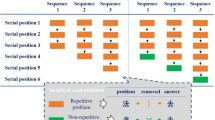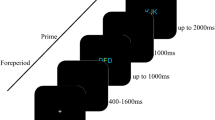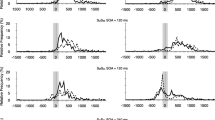Abstract
When subjects are confronted with sequences of stimuli that are constructed according to certain rules, they tend to improve their performance in terms of lower error rates and/or faster reaction times as compared to random sequences of the same stimuli, even if they are not able to report the regularities of events.
Similar content being viewed by others
References
Berry, D., & Dienes, Z. (1993). Implicit learning: Theoretical and empirical issues. Hillsdale, NJ: Erlbaum.
Cleeremans, A., & McClelland, J.L. (1991). Learning the structure of event sequences. Journal of Experimental Psychology: General, 120, 235–253.
Cohen, A., Ivry, R.I., & Keele, S.W. (1990). Attention and structure in sequence learning. Journal of Experimental Psychology: Learning, Memory, and Cognition, 16, 17–30.
Curran, T., & Keele, S.W. (1993). Attentional and nonattentional forms of sequence learning. Journal of Experimental Psychology: Learning, Memory, and Cognition, 19, 189–202.
Donchin, E. (1981). Surprise! ... Surprise? Psychophysiology, 18, 493–513.
Dulaney, D.E., Carlson, R., & Dewey, G. (1984). A case of syntactical learning and judgement: How concrete and how abstract? Journal of Experimental Psychology: General, 113, 541–555.
Eimer, M., Goschke, T., Schlaghecken, F., & Stürmer, B. (1996). Explicit and implicit learning of event sequences: Evidence from event-related brain potentials. Journal of Experimental Psychology: Learning, Memory, and Cognition, 22, 970–987.
Ferraro, F.R., Balota, D.A., & Connor, L.T. (1993). Implicit memory and the formation of new associations in nondemented Parkinson's disease individuals and individuals with senile dementia of the Alzheimer type: A serial reaction time (SRT) investigation. Brain and Cognition, 21, 163–180.
Hoffmann, J. (1993). Unbewußtes Lernen — eine besondere Lernform? Psychologische Rundschau, 44, 75–89.
Howard, J.H., Mutter, S.A., & Howard, D.V. (1992). Serial pattern learning by event observation. Journal of Experimental Psychology: Learning, Memory, and Cognition, 18, 1029–1039.
Keele, S.W., Jennings, P., Jones, S., Caulton, D., & Cohen, A. (1995). On the modularity of sequence representation. Journal of Motor Behavior, 1995, 27, 17–30.
Knopman, D., & Nissen, M.J. (1991). Procedural learning is impaired in Huntington's disease: Evidence from the serial reaction time task. Neuropsychologia, 29, 245–254.
Lewicki, P., Czyzewska, M., & Hoffman, H. (1987). Unconscious acquisition of complex procedural knowledge. Journal of Experimental Psychology: Learning, Memory, and Cognition, 13, 523–530.
Lewicki, P., Hill, T., & Bizot, E. (1988). Acquisition of procedural knowledge about a pattern of stimuli that cannot be articulated. Cognitive Psychology, 20, 24–37.
McCloskey, M., Harley, W., & Sokol, S.C. (1991). Models of arithmetic fact retrieval: An evaluation in light of findings from normal and brain-damaged subjects. Journal of Experimental Psychology: Learning, Memory, and Cognition, 17, 337–397.
Nattkemper, D., & Prinz, W. (1984). Costs and benefits of redundancy in visual search. In A. Gale & F. Johnson (Eds.), Theoretical and applied aspects of eye-movement research (pp. 343–351). Amsterdam: North-Holland.
Nissen, M.J., & Bullemer, P. (1987). Attentional requirements of learning: Evidence from performance measures. Cognitive Psychology, 19, 1–32.
Prinz, W. (1979). Integration of information in visual search. Quarterly Journal of Experimental Psychology, 31, 287–304.
Prinz, W. (1983). Redundanzausnutzung bei kontinuierlicher Suchtätigkeit. Psychologische Beiträge, 25, 12–56.
Prinz, W. (1986). Continuous selection. Psychological Research, 48, 231–238.
Prinz, W, (1990). A common coding approach to perception and action. In O. Neumann & W. Prinz (Eds.), Relationships between perception and action: Current approaches (pp. 167–203). Berlin: Springer-Verlag.
Prinz, W., & Nattkemper, D. (1987). Integrating non-target information in continuous search. Perception and Action (Report 155). Bielefeld, Germany: Zentrum fur interdisziplinäre Forschung.
Prinz, W., & Prinz, U. (1985). Verarbeitung redundanter Zeichensequenzen durch Kinder im Grundschulalter. Zeitschrift für Entwicklungspsychologie und Pddagogische Psychologie, 17, 210–222.
Reber, A.S. (1967). Implicit learning of artificial grammars. Journal of Verbal Learning and Verbal Behavior, 77, 317–327.
Reber, A.S. (1989). Implicit learning and tacit knowledge. Journal of Experimental Psychology: General, 118, 219–235.
Reber, A.S., & Millward, R.B. (1971). Event tracking in probability learning. American Journal of Psychology, 84, 85–99.
Rosenbaum, D.A., Kenny, S.B., & Derr, M.A. (1983). Hierarchical control of rapid movement sequences. Journal of Experimental Psychology: Human Perception and Performance, 9, 86–102.
Servan-Schreiber, E., & Anderson, J.R. (1990). Learning artificial grammars with competitive chunking. Journal of Experimental Psychology: Learning, Memory, and Cognition, 16, 592–608.
Shaffer, L.H. (1978). Timing in the motor programming of typing. Quarterly Journal of Experimental Psychology, 30, 333–345.
Shaffer, L.H. (1982). Rhythm and timing in skill. Psychological Review, 89, 109–122.
Stadler, M.A. (1989). On learning complex procedural knowledge. Journal of Experimental Psychology: Learning, Memory, and Cognition, 15, 1061–1069.
Willingham, D.B., Nissen, M.J., & Bullemer, P. (1989). On the development of procedural knowledge. Journal of Experimental Psychology: Learning, Memory, and Cognition, 15, 1047–1060.
Zießler, M. (1994). The impact of motor responses on serial pattern learning. Psychological Research, 57, 30–41.
Author information
Authors and Affiliations
Rights and permissions
About this article
Cite this article
Nattkemper, D., Prinz, W. Stimulus and response anticipation in a serial reaction task. Psychol. Res 60, 98–112 (1997). https://doi.org/10.1007/BF00419683
Received:
Accepted:
Issue Date:
DOI: https://doi.org/10.1007/BF00419683




